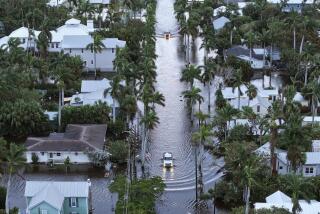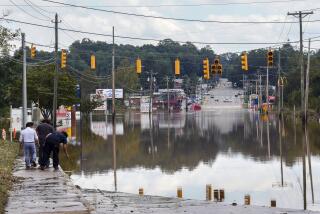Rancor rises with the water
LAPLACE, LA. — Michael Turner was sitting on his porch when the lake roared in. Hurricane Isaac had not even made landfall, but suddenly water was roaring like a big-river rapid through the neighborhood, swallowing streets that had never seen such flooding, not even after Hurricane Katrina.
“It was like a wave,” Turner said Thursday as boats plied the still-submerged neighborhood of River Forest in St. John the Baptist Parish, about 30 miles northwest of New Orleans. Some residents here suspect the improved, post-Katrina levee system that protected New Orleans during Isaac may have contributed to their misery by pushing more water back into nearby Lake Pontchartrain.
With Isaac’s wind direction pushing wave after wave out of the roiling lake toward LaPlace, and with the slow-moving storm dropping rain for 48 hours, the conditions were set for disaster. Downpours and flash-flood warnings continued to plague the area Thursday, where hundreds have been evacuated or rescued from Isaac flooding. The amount of damage has not yet been assessed.
Unlike New Orleans, where a newly fortified $10-billion flood-control system protected the city from Isaac, many outlying parishes have not yet seen substantial improvements since Katrina.
“We had an opportunity after Katrina,” said Karla Jones, as she watched boats travel down her street deeper into the flood zone. “Obviously, the message from Katrina didn’t get through.”
As she spoke, a front-end loader carrying a bewildered-looking family of four in its huge scoop headed out of the flooded zone. Down the street, a man who had tried to drive his pickup through the water tinkered beneath the hood, trying to revive the stalled vehicle.
Parish officials did not respond to calls for comment. But the problem extends to other outlying parishes -- including Plaquemines and Jefferson -- also the scene of severe Isaac flooding.
For several years local lawmakers have lobbied for construction of a better flood-protection system in these parishes. But the projects have been delayed by funding issues and disagreements with the federal government over proposed levee routes. Officials with U.S. Army Corps of Engineers did not return phone calls for comment.
“Isaac has reinforced for us once again the vulnerability of these areas,” Sen. Mary L. Landrieu (D-La.) said in a statement Thursday. “I am committed to pushing for improved flood protection for areas of our state that so desperately need it. There are still too many areas without protection, and we have a lot of work left to do.
As Isaac bore down, officials in Jefferson Parish south of New Orleans tried to protect towns against the torrents with 3,000-pound sandbags, so-called Hesco baskets and pumps, said John Young, parish president.
“But when you have the whole gulf coming at you, it just overwhelms the system,” he said.
Whether human failures or Mother Nature are to blame, the situation underscored the dependence people in this area of lakes, swamps, rivers and bayous have on levees. Resentment also surfaces over the perceived differences in how New Orleans is protected, while rural areas are inundated.
“They closed off New Orleans -- that’s why this happened!” an angry man yelled to nobody in particular as he steered his truck through some of the more manageable water in LaPlace’s River Forest neighborhood.
Throughout the neighborhood, the detritus of a massive storm was evident. A birdhouse lay on the ground. Small boats ferried people and belongings back and forth. One man pushed a canoe carrying two cats and a green bird in its cage. A walk down Somerset Street quickly turned into a slog through ankle-deep water, then knee-deep water, then water too deep to consider going any farther.
Turner knew something was wrong when he looked down Somerset Street and saw a line of vehicles speeding his way. Behind them was a wave of water, complete with white-caps.
“It looked like rapids,” said Eddie Ganucheau, who used his boat to help bring some of the stranded people out.
“The water started rising so fast -- the lake just came up. It looked like Katrina,” Lili Castillo said. Stunned, she told her daughters, “Just grab your stuff and go.”
On Thursday, boats still were going in to pluck people from the upper levels of homes they had refused to evacuate earlier. Michelle Bowers was one of them. Her long hair a wet tangle around her face, she said she had been sick.
She clambered from a small boat and into a waiting pickup, with no idea where she would go.
As Bowers left, Lenny Valentine was trying to get back to his house in the area of the worst flooding to see whether the nearly 6 feet of water on the ground floor had begun receding.
“Hey, can I rent that boat?” he yelled at someone passing by. They didn’t stop, but later, Valentine found someone willing to lend him a wobbly canoe and a couple of paddles.
He got in and set out for home.
--
Times staff writer Molly Hennessy-Fiske in Los Angeles contributed to this report.
More to Read
Sign up for Essential California
The most important California stories and recommendations in your inbox every morning.
You may occasionally receive promotional content from the Los Angeles Times.











